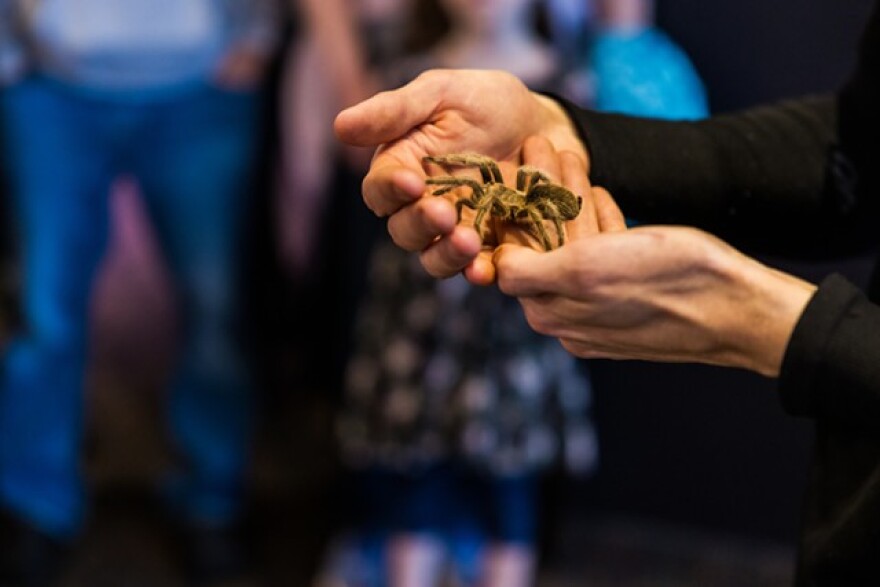Speed is a survival skill, but it isn’t the only one. That’s the point of “Survival of the Slowest: Counterintuitive Adaptations,” an educational exhibit featuring live animals at Rochester Museum and Science Center. It features reptiles, amphibians, arachnids, and a sloth named Sash — all relatively sedate species, whose measured movements and metabolisms help them make it in the wild.
The adaptation game isn’t one-trait-fits-all. Each creature is like a piece of a puzzle, its aspects shaped by the other components that surround it, like the scarcity of food or the kinds of predators it needs to avoid.
“Sometimes it’s the slowest, weakest, smallest that survives,” said the museum’s director of exhibits, Calvin Uzelmeier.
The specific animals in the exhibit are on loan from the Little Ray’s Nature Center, a Canadian organization that has a location in Syracuse, which also worked with the museum to train local animal experts to handle the animals and educate visitors through the run of the exhibit at RMSC. In addition to checking out regular feedings and presentations, visitors can pay an additional fee to take part in special meet-and-greet encounters, with the opportunity to touch and feed some of the animals.
Animals that really pace themselves, like the two-toed sloth, don’t use a lot of energy, so they don’t have to eat much, and they spend their time relaxing in treetops to avoid predators. The exhibit includes predators, too, like the ball python and two boa constrictors. These animals benefit from having slow metabolisms and can survive on infrequent meals when prey is scarce.
Some of the featured creatures can move fast, but choose not to, according to Brandon Soto, who manages the Syracuse location of Little Ray’s Nature Center. Take Fluffy the golden knee tarantula, who stays deathly still most of the time, only using her lightning-fast skills to ambush passing prey.
"These guys fit perfectly into the ‘survival of the slowest’ genre, because they have a very slow metabolism,” Soto said of Fluffy’s species. “And they could theoretically go up to two years without actually consuming food, so long as they have enough nutrients stored in their body.”

The green basilisk, Cairo, prefers to bask in the sun all day, but can really move when necessary.
"If he were to be put in the situation where he needs to make a fast dash, these guys can be referred to as the ‘Jesus Lizard’ because they can run across water at a very high speed,” Soto said.
Soto noted that many of the animals in the exhibit were surrendered by people who realized they weren’t equipped to give them the care they needed as pets. Part of the educational mission of Little Ray’s and this exhibit, he said, is to help people understand the specific needs of different species.
“Are you in the right setting to be able to take care of these animals?,” Soto said. “Can you properly take care of the animal by giving them the right amount of food, the right amount of light exposure? And can you take care of them for the entire duration of their life?”
Soto wants visitors to learn that animals are vulnerable to humans, even the ones that may intimidate people with their claws, fangs, scales, and scurrying legs.
"Here are animals that have been handled by our keepers almost every day, so they’re used to human exposure,” Soto said. “But if you were to encounter an animal in the wild, they have no experience with humans, and they are absolutely terrified of you. You're this giant creature that can potentially eat them, and they want to get away from you as fast as possible.”
At RMSC, all the venom, constricting muscles, and the seemingly cuddy traits are behind glass, animals and humans safe from one another. But for the patient observer, there’s plenty to learn.
“One of the wonderful things with animals is you'll see different behavior all the time,” Uzelmeier said, adding that repeat visitors will catch the animals in a variety of modes and moods.
"Survival of the Slowest” continues through May 19, 2024. More info here.
Rebecca Rafferty is an arts writer at CITY.

